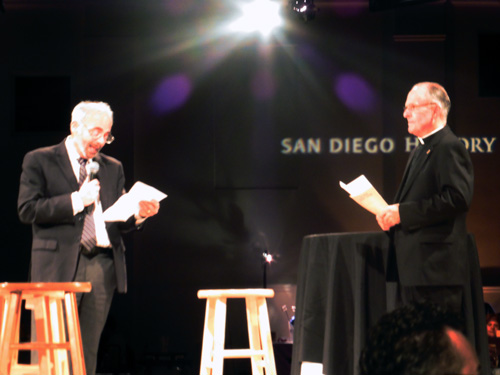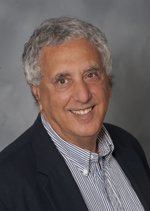
By Donald H. Harrison

SAN DIEGO—Although invocations by Rabbi Michael Berk of Congregation Beth Israel and Monsignor Richard Duncanson of Mission San Diego de Alcala came in reverse chronological order as far as San Diego history was concerned, they were in correct historical order from the standpoint of world history. Jews were first on the world stage, followed by the Catholics. In the City of San Diego, which traces its birth to a mass said at the Presidio by Father Junipero Serra, the Catholics came first (in 1769) and the Jews didn’t arrive until 81 years later (in 1850).
The two clergymen delivered their prayers, coupled with history lessons, at a packed function of the San Diego History Center on Sunday evening, April 26, at the Town & Country Convention Center. Honoring the “Centurions of San Diego,” the dinner at which many hosts and hostesses wore costumes from 1915, celebrated businesses and establishments – including Houses of Worship – that have flourished in San Diego for more than a century. The function came during the ongoing celebrations for this, the centennial year of Balboa Park.
Berk, speaking first from a central stage that required him and other presenters to gradually turn in circles as they gave their addresses so as not to ignore any of the hundreds of people in the audience, noted that “some 5,000 years ago a tiny, insignificant, ragtag tribe of middle easterners began spreading the rumor that there was only one God in the universe. About 4,850 years later, the descendants of the bearers of that message of Oneness reached the sunny isolated outpost called San Diego, California.”
Louis Rose, San Diego’s first Jewish settler, arrived in San Diego in 1850, followed in short order by such builders of the San Diego Jewish community and the general community as Lewis Franklin, Joseph S. Mannasse and Marcus Schiller—the latter of whom was the leader of Congregation Adath Jeshurun in the early 1860s, which was transformed in the late 1880s to Congregation Beth Israel. Schiller also was one of the City of San Diego Trustees who voted in the late 1860s to set aside 1,500 acres for the park land that years later was renamed from “City Park” to “Balboa Park” in anticipation of the 1915 Panama-California Exposition.
“While America waged a civil war in 1861 and nearly disintegrated, Jews here laid the groundwork for a community that during the last 154 years has thrived,” said Berk. “These courageous souls were hopeful that the promise of America would continue. Beth Israel, the Mother Ship of the Jewish community here, has given birth to an extraordinary Jewish community, and we take a great deal of pride in that.”
Perhaps presaging an exhibition by the San Diego History Center that is under consideration for the near future about the contributions of the Jewish community to San Diego, Rabbi Berk continued: “During those years, Jews have served the civic community with honor and distinction. We Jews are grateful for the welcome we have always felt here in San Diego; and in return have contributed our efforts to make San Diego a sophisticated, vibrant, creative, cultured and tolerant place for all who are privileged to call this place home. Jews have made stunning contributions in the arts, business, cultural and social justice work that has made San Diego one of the finest big cities in America; a big city that works.”
Berk went on to explain that “at a moment like this we Jews utter a simple prayer that thanks God for allowing us to be alive for a celebration such as this evening.” He then recited the Shehekiyanu prayer in Hebrew, eliciting from Monsignor Duncanson, who was standing on the stage with him, a smile of recognition.
Duncanson described himself as the “22nd successor of Father Junipero Serra,” and added that “we continue to be a vibrant Catholic community here in Mission Valley” – in which both Mission San Diego de Alcala and the Town and Country Hotel are located.
“On this very special occasion, as we join the 2015 makers of San Diego history in honoring the Centurions of San Diego, we ask that You deepen our awareness of Your constant presence among us, for it is truly through Your saving grace, and for more than 100 years now each of these historic businesses, hospitals, libraries, schools, churches, synagogues, trade and public organizations have provided the leadership and community service in assuring the ongoing growth and development of the San Diego region,” the monsignor continued.
“These historic institutions are represented this evening by the many distinguished Centurions of San Diego who are gathered here and who are being recognized and honored by the San Diego History Center during this beautiful celebration of the centennial of Balboa Park and the Panama-California Exposition.
“Acknowledging our deep gratitude to these pioneers who founded all these great institutions, we prayerfully invoke your continued blessings on those who proudly carry on the work of their predecessors. We prayerfully invoke also your continued blessings on the San Diego History Center as it so beautifully tells the diverse story of our region’s past, present and future while educating and enriching our community, preserving our history, and fostering civic pride.”
Duncanson ended his invocation with the prayer, “May all glory and praise be Yours, now and forever, Amen” – which is a format suited to inter-religious occasions such as this one in which he shared the stage with a rabbi. At all-Catholic, or all-Christian gatherings, the monsignor might have ended his prayer invoking not only God, but the name of Jesus in addition.
The next speaker at the function was KUSI meteorologist and reporter Dave Scott, who was joined by a barbershop quartet styling itself as the Tuesday Night Alibi. The quartet sang snippets of old songs, such as “Happy Days Are Here Again” to honor various businesses established in San Diego before and during 1915. These included, among others, the San Diego Union-Tribune, San Diego Gas & Electric, Frazee Paints, Neyenish Printers, Fidelity National Title Insurance, H. G. Fenton Company, Barney & Barney, Frost Hardwood Lumber Company, Willis Allen Real Estate, and Lyon Technologies.
Scott was followed to the stage by Union-Tribune columnist Logan Jenkins, a fourth-generation San Diego County resident, who grew up in Coronado and remembered some of the businesses he would encounter after taking the ferry across the harbor to San Diego’s lower Broadway. ,Some of these businesses were designed to attract the patronage of sailors on shore leave. Perhaps they were not glamorous, but they were indeed part of San Diego’s history.
Copies of the Journal of San Diego History, along with other historic books and pamphlets, were distributed to party-goers. Centerpieces of geraniums invoked the century-old debate between those who favored “smokestacks” — that is industrial development of San Diego — versus those who favored “geraniums,” that is leaving San Diego in a more pastoral state.
*
Harrison is editor of San Diego Jewish World. You may comment to donald.harrison@sdjewishworld.com, or post your comment on this website provided that the rules below are observed.
__________________________________________________________________
Care to comment? We require the following information on any letter for publication: 1) Your full name 2) Your city and state (or country) of residence. Letters lacking such information will be automatically deleted. San Diego Jewish World is intended as a forum for the entire Jewish community, whatever your political leanings. Letters may be posted below provided they are responsive to the article that prompted them, and civil in their tone. Ad hominem attacks against any religion, country, gender, race, sexual orientation, or physical disability will not be considered for publication. There is a limit of one letter per writer on any given day.
__________________________________________________________________